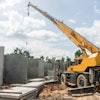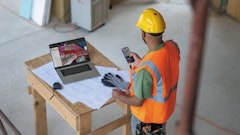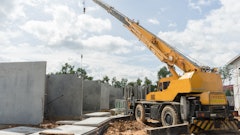
The construction industry isn’t known for embracing technology. In fact, it ranks as one of the least technologically advanced industries. But this perception doesn’t have to define its future.
After 35 years working with contractors, I’ve seen how firms navigate shifting markets firsthand. What’s clear today is that technology is no longer optional. Cloud platforms, field apps and even AI aren’t here to replace people — they’re here to help teams work smarter and bridge gaps created by the labor shortage.
It’s time to reframe how we think about technology in construction, because the real obstacle isn’t the tools — it’s the misconceptions that keep contractors from using them.
The Labor Shortage Threatens Construction’s Future
To meet this year’s demand for construction services, the industry must attract an estimated 439,000 net-new workers.
An aging workforce compounds the problem. By 2030, the average age of craft workers will reach 46, and fewer than 3% of young people say they are considering careers in construction. This leaves the industry with more positions to fill and at risk of losing the practical knowledge and problem-solving skills that retiring workers take with them — without a clear pipeline to replace that expertise.
Fortunately, global construction spending is projected to rise from $13 trillion in 2023 to $22 trillion in 2040, signaling enormous growth potential for contractors who can adapt.
Construction is at a crossroads. A growing labor crisis and rising project demand are forcing firms to realize that they can no longer rely on disconnected systems and manual methods to keep pace. Contractors who embrace technology can streamline operations, cultivate expertise and maximize the capacity of their teams — starting with letting go of long-held myths about construction tech.
4 Tech Myths That Are Costing Contractors
Many contractors hesitate to adopt new tools because technology seems like a poor fit or an unnecessary expense. Here are four common misconceptions and why they no longer hold up.
1. “Tech doesn’t fit a hands-on industry like construction”
Some contractors view technology as disconnected from construction’s physical, boots-on-the-ground nature. After all, building happens in the field, not behind a screen.
Construction will always be built by people, but technology ensures those people can focus on what they do best. Cloud-based platforms connect the office and jobsite with real-time labor hours, scheduling and job costing data. Paired with construction accounting software, this creates a single source of truth for payroll, budgeting, productivity, financial reporting, and compliance, so decisions are made with accurate, up-to-date information.
Mobile accessibility extends this connectivity to crews, allowing them to clock in, log expenses, and submit updates directly from the field. These tools streamline daily tasks and keep projects moving forward by cutting out paperwork and delivering instant visibility to managers.
2. “The workforce won’t adapt to new systems”
I often hear concerns that employees — particularly older workers — won’t embrace new technology. In reality, adoption is seamless when tools mirror existing workflows and simplify familiar tasks instead of overhauling them.
Mobile apps are a good example: rather than filling out paper timesheets at the end of the week, crews can submit hours and capture field notes with just a few taps, often on the same smartphones or tablets they already use on the jobsite.
Cloud platforms also ease adoption. They’re accessible anywhere, meaning companies can introduce features gradually to give teams time to adjust. Intuitive dashboards and shared data can eliminate redundant entries and keep information consistent, ensuring workers spend less time on admin and more on the job.
Younger workers expect this level of efficiency and convenience. Offering modern, mobile-friendly tools signals that your business is forward-thinking and values employees’ time, a critical factor in attracting and retaining the next generation during a labor crunch.
3. “AI and automation will replace workers”
The fear that AI will eliminate jobs is widespread, but it does the opposite in construction: AI handles repetitive, time-consuming tasks so teams can focus on skilled work.
AI can generate reports, scan invoices for duplicate charges, flag cost overruns before they escalate, and analyze past projects to forecast labor or material needs. These capabilities give you greater control over costs and schedules, helping you make smarter decisions from the start.
Rather than replacing people, AI amplifies their impact and ensures teams can accomplish more with the time they have.
4. “Technology is too expensive for small and mid-sized contractors”
The cost of new technology is a fair concern, especially for smaller firms. But modern solutions scale to fit businesses of every size.
Contractors can start with essentials like payroll or accounts receivable and expand as their business grows. Features like WIP reporting or detailed job cost tracking can give smaller firms the same financial visibility as their larger competitors — without requiring a significant upfront investment.
The bigger risk is inefficiency. Miscommunication, rework, and project delays can drain profits far faster than a software subscription ever could. The right system quickly pays for itself by streamlining processes, keeping projects on schedule and margins intact.
Building A Future That Works Smarter
The labor shortage is real — but it doesn’t have to limit the construction industry’s growth.
Cloud solutions, mobile apps, and AI are practical tools built to help contractors bridge labor shortages, streamline operations, and boost productivity. With the right solutions in place, contractors can give their teams the support they need to focus on skilled work, while systems handle routine tasks in the background. Don’t be afraid to start small by digitizing payroll or adopting a mobile app. Each step forward can free your team from repetitive tasks and strengthen your ability to do more work, with fewer hands.
The construction industry must step into a future that embraces technology, not resist it — a future that’s still built by people, but empowered by more intelligent, faster systems that make every hour on the job count.


















